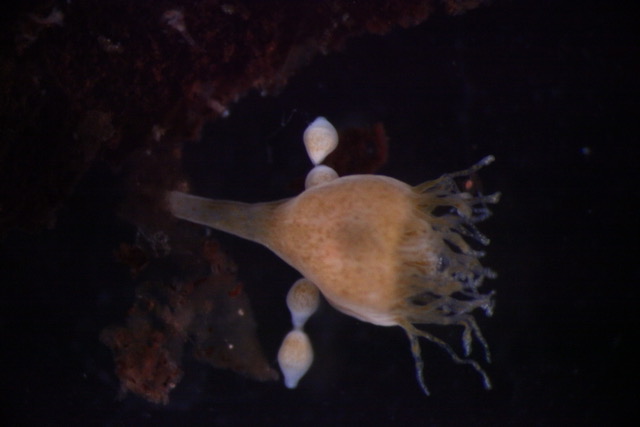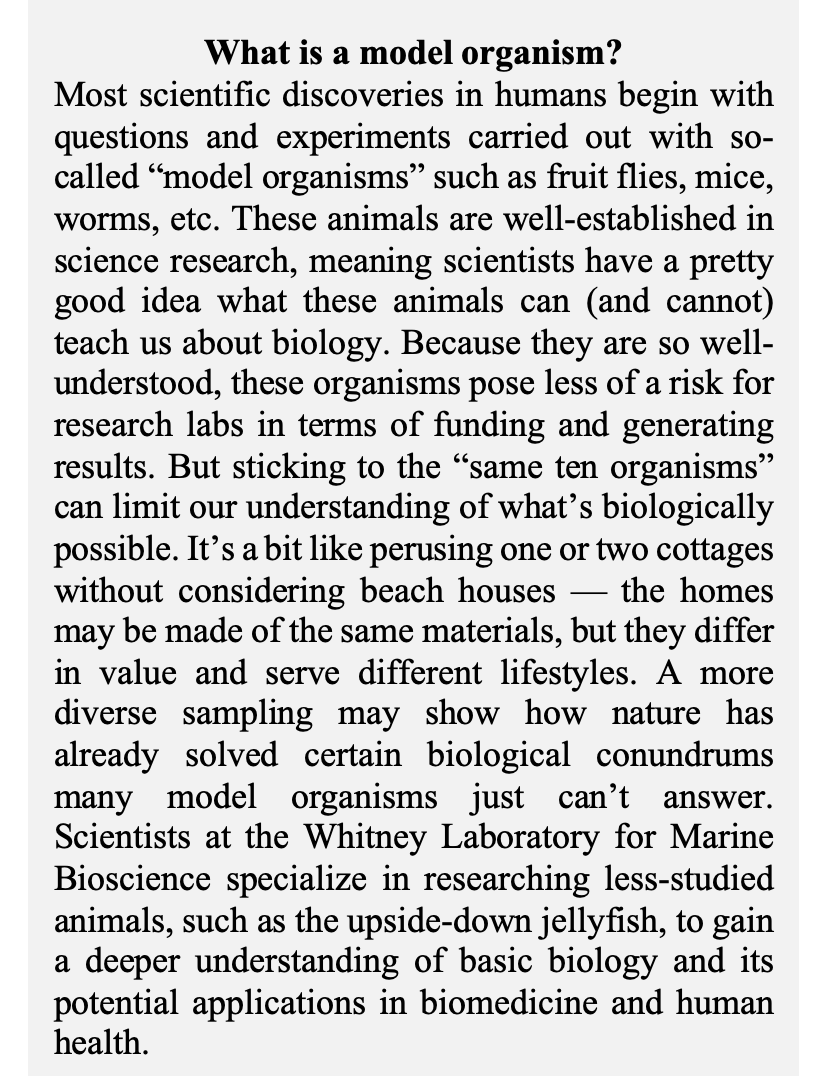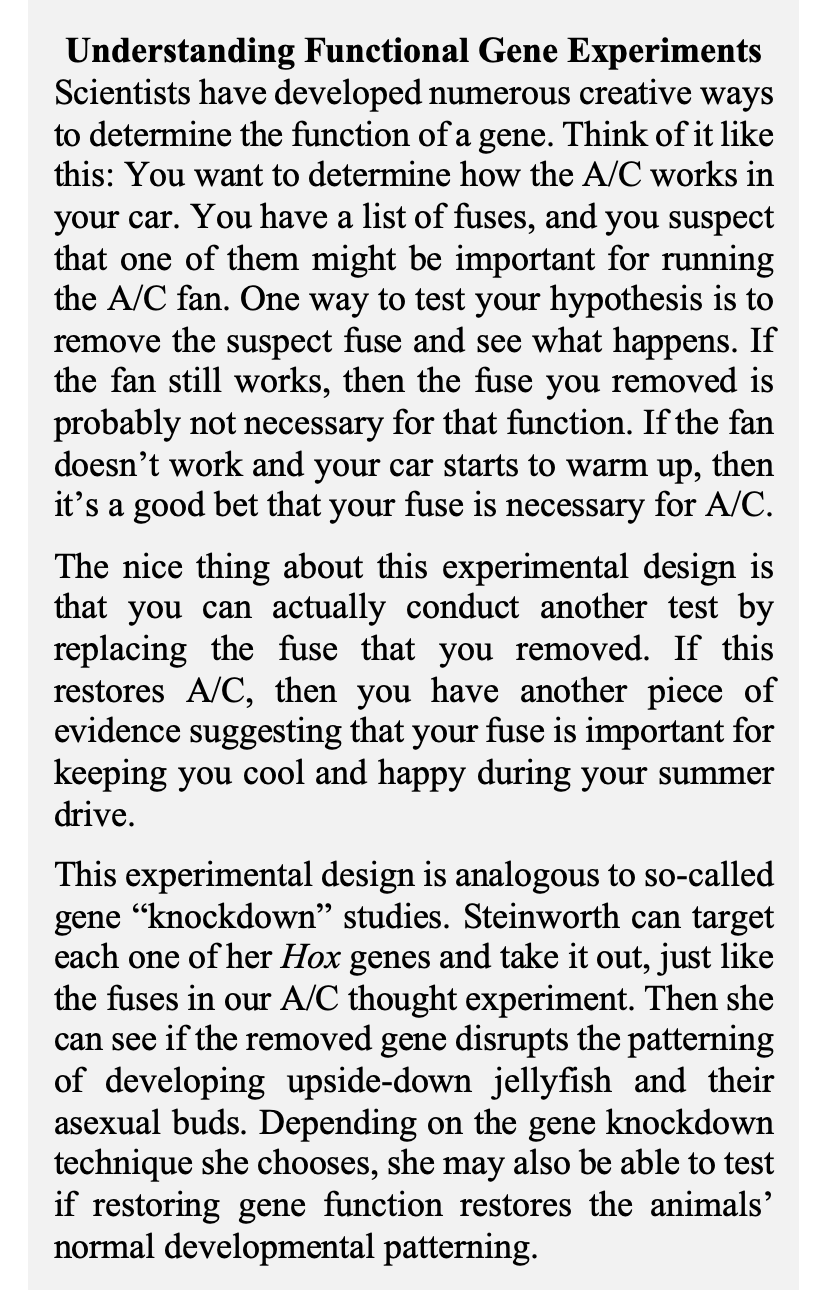Beyond the birds and the bees
Posted by Brent Foster, on 24 April 2023
“It’s like growing a clone of yourself out of your arm,” Bailey Steinworth said, gesturing to her own arm to illustrate one of the ways Cassiopea xamachana — the upside-down jellyfish — reproduces. It’s a sunny day, and we’re sitting at picnic tables outside the University of Florida’s Whitney Laboratory for Marine Bioscience. Steinworth, a graduate student at the Whitney Lab, studies the upside-down jellyfish to understand genes involved in body patterning.
“Actually, you probably wouldn’t want a full clone of yourself,” she amended, “but you might want to grow something else, like a kidney.” Of course, our ability to grow kidneys out of our arms is — pardon the pun — currently beyond our reach.
Steinworth’s example touts the need for a more biologically diverse pool of research organisms to learn about nature’s ingenuity. As “complex” as human beings and other vertebrates are, they don’t always have the biological capabilities of more “primitive” species, such as Cassiopea. On a simpler scale, the upside-down jellyfish lives up to its name with its unique and quirky attributes that makes it, well, so cool.
Cassiopea is a scyphozoan, or “true” jellyfish, that is capable of both sexual and asexual reproduction. As humans, we’re more familiar with sexual reproduction — some of you parents will remember having the talk about the birds and the bees, with its confusing and crisscrossed metaphors making you and your children’s faces turn red.
A fertilized Cassiopea egg produces an embryo that develops into a swimming dot roughly the size of the period at the end of this sentence. This swimming dot, called a “planula,” then settles on the ocean floor as a stationary polyp with tentacles to capture swimming prey. Eventually the polyp will undergo metamorphosis and become a mature adult Cassiopea, or “medusa,” after which the cycle begins anew.
But here’s where things get interesting. At the polyp stage, Cassiopea can undergo asexual budding. These buds are kind of cute, “like tiny little sausage-links on a string,” according to Steinworth. And if you look at these little buds under a microscope, you might notice they look similar to the swimming dot-of-a-planula. And just like the planula, this swimming bud will eventually settle and develop into another polyp.

“When you see a polyp, you can’t tell if it came from a planula or a bud,” Steinworth explained. This observation led her to ask the “big” question that became her PhD dissertation topic: Do asexual buds use the same genes as developing embryos? This question addresses a fundamental gap in the field of developmental biology, and answering it would show one way developmental genes may be used for more than one main purpose during a complicated lifecycle, a possibility that could translate to gene therapies and regeneration research.
But it’s too large and difficult to answer with a single set of experiments. Rather than taking the question as a whole, Steinworth is focusing on a subset of genes thought to be important for body patterning.
As organisms develop, their bodies become regionalized — a fact we may take for granted but which immediately becomes evident when we consider that feet don’t usually grow out of our noses. Over the past century, scientists have identified groups of genes that are necessary for establishing body regions during development. One of these subsets of genes, called Hox genes, is believed to be responsible for establishing what scientists call the “primary axis” (think head to tail).
Steinworth is using this underlying knowledge as a steppingstone to determine whether Hox genes expressed during asexual budding in Cassiopea have the same function as those expressed in a swimming planula. Her first step was to see if the upside-down jellyfish even has Hox genes.
“Hox genes seem to be fairly consistent in most ‘model’ organisms,” Steinworth explained. But it’s less certain what Hox genes might be doing in other organisms like jellyfish that have no clear front and end. Believe it or not, the scientific community still has arguments over questions like “Is the mouth of a jellyfish its anterior or posterior end?” or “How does a jellyfish’s body plan compare to other animals?”

In a recent paper published in Genome Biology and Evolution, Steinworth maps the relation of Hox genes in the upside-down jellyfish to other animals. She hoped that by comparing enough species she could clarify the evolutionary history of Hox genes and get some clear answers about their role in patterning a body plan. Unfortunately, that’s not what happened.
It’s unclear exactly how Hox genes in jellyfish relate to Hox genes in other animals. It’s as though some of these genes have been lost over time, though it’s possible that they just diverged — science-speak for mutating in such a way that they have developed a new function. The true evolutionary scenario, Steinworth notes in her paper, is likely some combination of the two possibilities. There’s just no way to know for sure.
“If I think about it too long, I get lost in the fundamental unknowability of the universe,” Steinworth said with a laugh.
But there are other ways to address Steinworth’s research question. Recently, she’s been conducting a bit of molecular detective work to tease out how Hox genes are expressed in the upside-down jellyfish. Her figures show Cassiopea in various developmental stages with differing patterns of gene expression — a regular “who-dunnit” line-up of every possible Hox gene suspect.
“These expression patterns tell us where and when these genes are expressed,” Steinworth said, “but they don’t necessarily tell us about their function.” That question is Steinworth’s next step in her PhD project, but answering it is not without its own challenges. Because Cassiopea is not an established model organism, most molecular techniques have to be extensively tested and validated before Steinworth can draw any conclusions.

Steinworth’s pursuit illustrates how conducting basic science research can sometimes be a tedious experience, filled with lows and highs of overcoming challenges and discovering the key principles necessary before we can try translating research into something “useful.” At its core, research like this highlights the power of leveraging biodiversity to see what nature is capable of achieving. Progress can be slow when developing tools in new organisms, but patience and perseverance can open doors in ways we can’t predict right away. While humans can’t grow kidneys from their arms (yet), Steinworth’s work will show how developmental genes have evolved and might be repurposed.
“It gives us insight into really early animal evolution,” Steinworth said as our picnic-table conversation draws to a close. “I think that speaks to a fundamental human curiosity to understand what life used to look like.”


 (2 votes)
(2 votes)